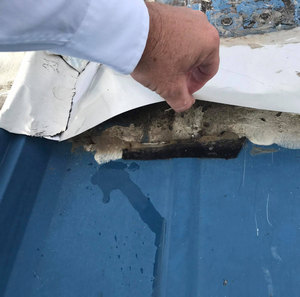Contractors in our group are asked frequently by clients if it is possible to “waive the insurance deductible” on an insurance claim for roof expenses. This is not an easy question and can put contractors in a sticky situation because there are no good answers to give a property owner.
Many residential owners are led to believe, by convincingly professional contractors, that it is “completely legal” to cover a deductible on insurance repairs. Surprisingly, this is becoming the norm for roofers; they openly advertise “Free Roof” on marketing material such as yard signs and door hangers. No wants to be called out for being in the wrong and especially on such a common question. So, what we’re going to do is explain the insurance claim process and provide some helpful tips.
Quality work is better than bad morals
 Unfortunately, the longer we’re in this industry, the more we see a startling trend of legitimate contractors exchanging deductibles for repair work and it conflicts with our business model. We can either throw away the quality service we provide and minimize costs with cheap workers and poor quality materials; or, we could educate and provide our useful knowledge to our clients on topics like the insurance claim process, our roofing systems, and the success factor of selecting a reliable contractor.
Unfortunately, the longer we’re in this industry, the more we see a startling trend of legitimate contractors exchanging deductibles for repair work and it conflicts with our business model. We can either throw away the quality service we provide and minimize costs with cheap workers and poor quality materials; or, we could educate and provide our useful knowledge to our clients on topics like the insurance claim process, our roofing systems, and the success factor of selecting a reliable contractor.
One thing that amazes us is that most people are more ready to take a blind shot with a cheap and amateur roofing contractor than a low quality car body shop. This is absolutely ridiculous considering that a house is much more expensive than a car, and our skilled applicators are executing some extremely dangerous work. The icing on the cake is that there will be stories about property owners getting scammed by “professionals” offering some ludicrous deal who will eventually close their business after raking in $1,000s in insurance collections.
Sadly, this is what much of the roof industry has formed into: local contractors with low budgets providing amateur workmanship, low-grade materials and kicking back money to customers because they fail at providing a service that is worth the insurance proceeds they are receiving. Top it all off with the fact that many of these contractors illegally funnel money from an insurance claim to the property owner and it puts more clarity into why 80% of roofing contractors go out of business within 2 1/2 years (Source: 2008 BBB).
It used to be a normal practice
Need a Trusted Expert?
Our group works together to provide:
- Larger Base of Knowledge
- Group-Wide Accountability
- Set Standards for Service
- More Peace of Mind
This insurance claims process does not work the same as today’s process. Many property owners today have Replacement Cost Value (RCV) provisions in their insurance policies. This allows insurers to limit their probability of an RCV insurance claim by cutting down payments into multiple parts. This means that now instead of receiving one main check, it can come in up to as many as 4 checks and will usually bear the name of the owner of the property as a cosigner. If a property owner wants to receive the entirety of the insurance claim, they would have to go through a licensed contractor to bill the insurance company and the mortgage company for the completed work.
Let’s look at an example. A property owner’s roof is damaged by a storm. The property owner files an insurance claim and insurance estimator is sent to your location. The insurance estimator says that the damage will cost $10,000 in repairs. The property owner has a $1,000 deductible, which is removed from the estimate. The roof is not in brand new condition, so the deterioration of the roof (we’ll give it $5,000 to make it easy) is removed from the estimate. The main check is written for $4,000 instead of $9,000. When an invoice of $10,000 or greater is received from a roofing contractor, the remaining $5,000 becomes recoverable. This ensures that the check is written to the mortgage company listed.
How do roofing contractors “waive” deductibles?
To be straight forward, they’re lying to the insurance and mortgage companies. The insurance policy of the property owner is strictly a contract between said property owner and the insurance company. With this contract, property owners can trade annual premium for protection against unexpected and disastrous damages to their properties minus a deductible. As usual, you have legal protection if your insurance carrier was to break your contract and refused to reward a claim. However, your insurer also has legal protection from YOU if you fail to meet your stated obligations (or you provide false information to save money on your deductible). A number of roofing contractors will market their services using a yard sign, which they claim can be used as an “advertising credit” for the deductible amount. If you’re going to invoice for the entirety of your insurance claim, you must make clear the amount being used on the project to the insurer. A contractor cannot charge the insurance provider $10,000 for roofing work they actually provide for $9,000. This basically means the contractor is purposely increasing the price to replace the amount missing.
If the insurers knew the work is being done for less, they would lower the amount of money set for the project. Here’s an example: If the insurance provider finds out that the property owner had the roofing work done for $9,000 instead of the allotted $10,000, only $8,000 would be released instead of $9,000. The insured would still have to fork over the $1,000 deductible to the contractor. In summary, this disclosure between the price invoiced to the insurer and the price invoiced to the property owner is a breach of contract between the insured and the insurer.
A number of roofing contractors will debate that is completely up to the contractor to decide how they get their work. They believe that if they want to pay a client $1,000 to get the project, they should be able to do so regardless of whether an insurer is involved. To make matters even worse, if the contractor is just writing a check to the property owner for “advertising”, this would require the filing of a Form-1099 to the property owner as the Federal Government requires transactions larger than $600 to be declared and that the property owner should pay income on the transaction.
This technique is borderline criminal and it’s best not to try it because someone will get caught in the end. It leaves us with an uneasy feeling, since false information is provided to the insurance company. How many major companies have you seen with a business model built around providing illegitimate information to cut checks?
At the end of the day, if your insurance provider were to catch the contractor or yourself, don’t count on the contractor to take all the legal blame. Be wary with contractors like these! They may be cheating the system on your behalf, providing low quality work on your roof, or stamping your name on a false invoice they give to your insurer. With anything you do, always be sure to research it well and choose a contractor with a reliable record of customer satisfaction. Don’t get caught on a “great deal” and never hand your money to the contractor before the job is done.


